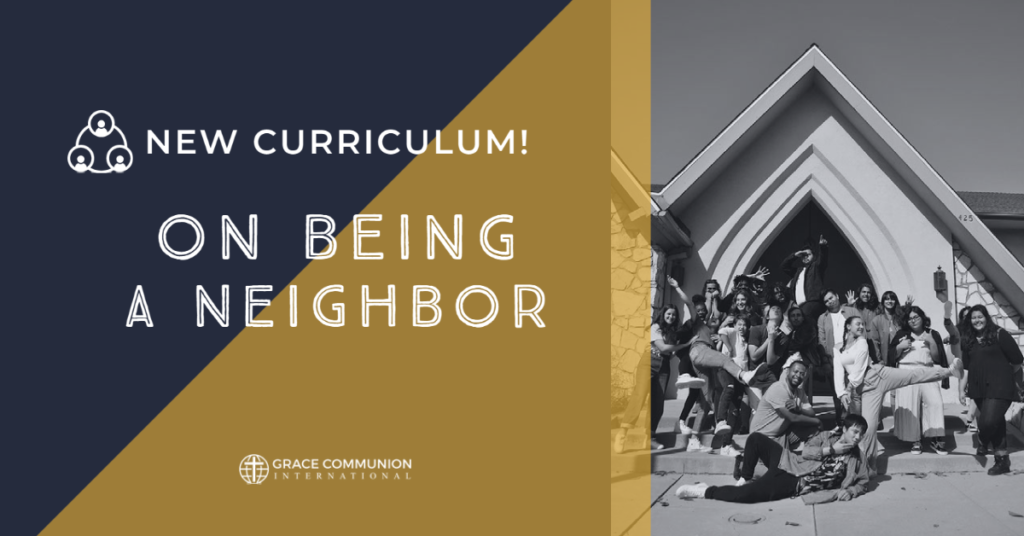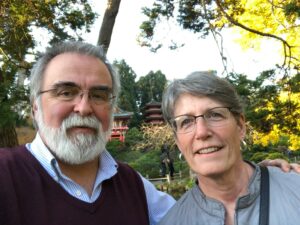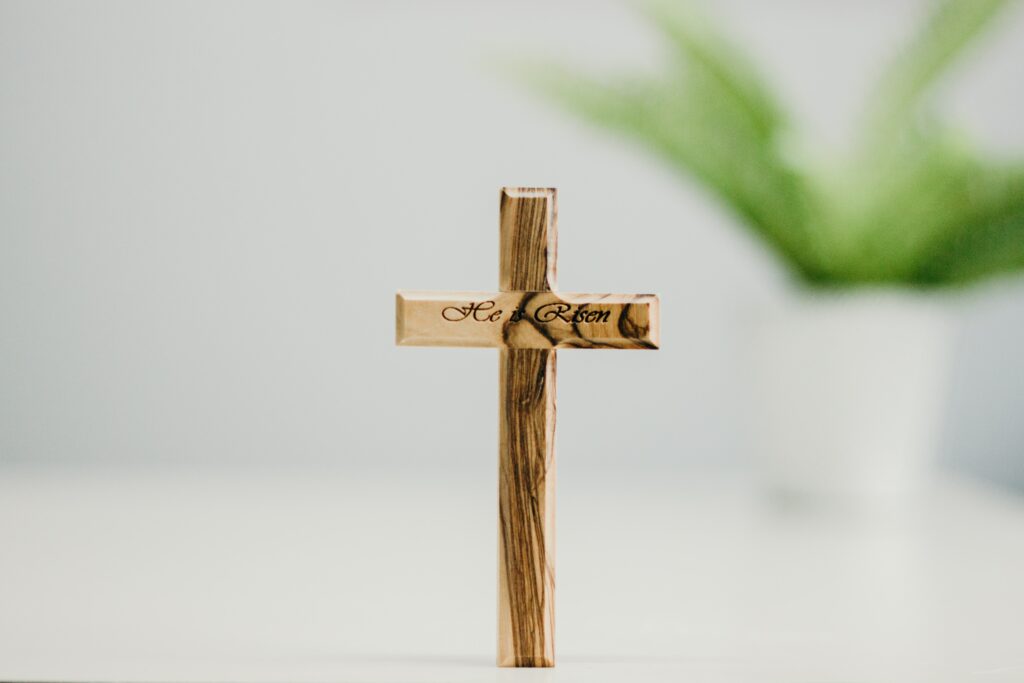Speaking Of Life 3020 | Life in a Handful of Dust
Throughout the Bible, God uses dust to reveal how he can transform something lifeless into something wonderful. Even now, God continues to breathe life into us and he can restore what is broken and change it into something amazing.
Speaking Of Life 3020 | Life in a Handful of Dust
Greg Williams
John starts his gospel work “In the beginning.” Later Jesus creates sight for a blind man with a handful of dust. After his resurrection, he meets Mary in a garden on Easter morning. In the Upper Room, he breathes on his apostles. Notice John’s words:
Jesus said to them again, “Peace be with you. As the Father has sent me, even so I am sending you.” And when he had said this, he breathed on them and said to them, “Receive the Holy Spirit.
John 20:21-22 (ESV)
Throughout the gospels, most vividly in John, we see the familiar images of dust, gardens, and breath. History started this way, in the garden, where God first breathed life into Adam. Here at the start of the New Testament church, Jesus begins the whole process again, by breathing the Spirit into us.
There’s that Hebrew word for breath—ruach—the word for Spirit.
Instead of destroying us for our rebellion and for turning from him, instead of starting over with a scorched earth policy from the ground up, God came here himself to re-create. These echoes of creation remind us that God always kept a remnant, Noah, the Exodus, the people brought back from exile. And then he brought forth his Son from one family, one woman, one womb.
He kept the remnant because that was his plan all along. He is the God who re-creates. He takes the dust and waste that sin has turned the world into and starts his kingdom here and says, “It is good.”
Has he breathed life into the dust of your life? Has he taken what is lifeless and dry and made it live? Think of the addict who is healed and goes onto support other addicts. Think of a mother who was hurt and abused as a child, but was then given her own children to cherish and break that cycle of pain.
We live in a world of death and resurrection with a God who, over and over, breathes life into a handful of dust. How is he breathing life into you?
I’m Greg Williams Speaking of Life.
Psalm 133:1-3 • Acts 4:32-35 • I John 1:1-2:2 • John 20:19-31
The theme this week is the God we touch, touches us. The call to worship Psalm talks about the miracle of God among us. His bringing us together is celebrated in all its healing reality. In Acts 4, God is present in the fellowship of the new church and the gritty reality of navigating relationships and generosity. In 1 John, John talks about touching Jesus himself, and then touching him again through the spiritual fellowship of the church. Our sermon is on John 20, and explores the kind of people Jesus chose to touch, revealing himself to weaklings, doubters, and cowards after the resurrection.
A Woman, a Doubter, and a Coward
John 20 and 21
The resurrection appearances of Jesus are some of the most famous and most strange of the Bible stories. Jesus dies a brutal death at the hands of the authorities—absolutely no question what happened to him. He’s put in a donated grave and the mourning process begins.
…but it doesn’t.
First there are strange rumors. Somebody saw something, we’re not even sure. As Mark writes his last fragmented line:
So they went out and fled from the tomb, for terror and amazement had seized them; and they said nothing to anyone, for they were afraid. (Mark 16:8 NRSV)
Then Jesus is showing up in the middle of locked rooms. He’s walking on paths with people who’ve know him for years and they don’t recognize him. Then as soon as they pray over a meal, they do recognize him—then he disappears! Then he’s gone—he’s back—he’s cooking breakfast. He’s talking to hundreds of people—then he’s gone again.
They watched Jesus die and, just as surely, he stands there right next to them. How one thing is connected with the other, no one quite knows.
…but it happened.
And even the Gospel writers seem at a loss. These controlled, intricately woven narratives end in fragmentary stories that feel like someone is trying to describe a nuclear blast.
John goes into more detail for more time than anyone else. Typical of his narrative structure, he provides us with one-on-one conversations with Jesus. He interweaves these with the stories the rest of the Gospels give us after the resurrection.
Let’s look at three stories—Mary Magdalene, Thomas, and Peter. Let’s notice what kind of people Jesus chose to have these post-resurrection conversations with. Who did he get close to? What does that tell us about him?

Easter Day—Mary, the Woman
Early on the first day of the week, while it was still dark, Mary Magdalene came to the tomb and saw that the stone had been removed from the tomb. (John 20:1 NRSV)
Here’s a woman walking by herself in the dark to a tomb. Women by themselves in the half-light isn’t a good idea now and it wasn’t then. The atmosphere is already tense and lost—this small, sniffling shadow stumbling her way through the tombs on a cold morning.
We don’t know much about Mary, other than the fact that she was confused with a few other Marys in the story. No, she wasn’t Lazarus’s sister. No, she didn’t wash Jesus’ feet with her hair.
One of the only details we have about her is that “seven demons” had been driven from her (Luke 8:2). We have to frame that as well within the first-century mindset. They would have thought not only of demonic harassment (a very real thing), but also would have put physical and mental issues under this category.
Other than that, we know very little except that she was always there. Always. She shows up in many places as “also appearing.” No doubt she followed along with the growing entourage of Jesus and was determined to follow him despite all costs.
So we have a lady who has no great lines so far, and seems to have nothing else going on in her life other than following around this eccentric savior character from Nazareth.
Complicate this with her gender. As a woman she was nearly powerless and non-existent in the world at that time. In Jewish society she had some rights and some voice, but in Greco-Roman society she was hardly noticed. The acute irony for Mary, as we shall see, is that her testimony didn’t count in legal matters, the word of a woman was no good.
And yet, in every Gospel, she’s the first one to witness Jesus risen from the tomb…
When she had said this, she turned around and saw Jesus standing there, but she did not know that it was Jesus. Jesus said to her, “Woman, why are you weeping? Whom are you looking for? (John 20:14-15 NRSV)
Mary, a woman whose testimony would be dismissed out of hand, is the first witness of the most important event in history! Throughout history, Mary has been nicknamed “the apostle to the apostles”—she was the first to carry the message, the first to sound the alarm. “Umm….Peter, John—guys, you’re not gonna believe this…”
The slapstick exchange in which she mistakes Jesus for the gardener is one of the funniest moments in literature. Here’s Jesus grabbing the first clothes on hand which happen to be the landscaper’s apron and floppy sunhat, and he walks up to this woman. Here is the Lord in a world in which sin is defeated—playful, just out of the corner of your eye.
And just as the great tragedy of humanity was born of a conversation with the first woman in a garden, so the great rebirth of humanity begins in this garden. This time it’s with a woman who is anything but the perfect Eve, and who is alone and despondent and lost, and doesn’t even know who she’s talking to.
And then there’s the moment that she recognizes him:
Jesus said to her, “Mary!” She turned and said to him in Hebrew, “Rabbouni!” (which means Teacher). (John 20:16 NRSV)
He says her name. The absolute intimacy of that moment as contrasted with the alienation of the Genesis story in which God says, “Where are you?” Here God is the one doing the seeking, even when he’s not being sought (he’s even the one doing the hiding for a moment!), and he speaks her name, and she knows him.
John can’t even help himself here but has to describe the exchange exactly as it was spoken: Rabbouni! She yells in Aramaic. Rabbouni! The one I know! The one who speaks my name!
This is the person that Jesus seeks out to show himself to first. This is the bell tone of the new world after the resurrection. No longer will people whom society deems a burden be left out of the party. They will be at the seat of honor. Their testimony will be heard.
A Week after Easter—Thomas, the Doubter
But Thomas (who was called the Twin), one of the twelve, was not with them when Jesus came. (John 20:24 NRSV)
Thomas wasn’t with them. This is an itchy, mysterious detail that John includes. We don’t know why Thomas was missing or where he was. His brief moments in the story previously show us a thin thread of character development.
Thomas, who was called the Twin, said to his fellow disciples, “Let us also go, that we may die with him.” (John 11:16 NRSV)
Here we see the early Thomas. The man who says esoteric, emotional things about dying with this Rabbi. But the more he has to wait, the more Jesus’ kingdom doesn’t look like he wants it to, the more cynical he gets.
We see him again later:
Thomas said to him, “Lord, we do not know where you are going. How can we know the way?” (John 14:5 NRSV)
Some time has passed. Thomas the young idealist is a little more hesitant. His voice has an edge to it. We see this confusion much of the time through Jesus’ interactions with the disciples. But Thomas is the only one that seems to show some development, this hardening from innocence to bewilderment.
And that’s the Thomas we catch up to in the end. The one who wasn’t there when Jesus first appeared to the disciples. Was he out somewhere on a drinking spree? Was he drowning his worries somewhere—watching his people lose yet one more Messiah?
And yet he’s back the next week.
A week later his disciples were again in the house, and Thomas was with them. (John 20:26 NRSV)
He’s gone, he’s back. He’s almost between two worlds, like Jesus himself. He’s confused and uncertain, doesn’t know what to think. One week he’s off the ranch, done with the whole thing. The next week he’s there with them because, despite it all, he’s got nowhere else to go.
Thomas has already told them that unless he can touch the wounds himself, he will “in no way” believe. He’s emphatic, he’s not getting taken again. At that time in history, Messiahs came and went with the desperate, occupied Jewish people. They started movements, made promises and then ran off with the money or ended up on crosses themselves. Thomas may be thinking that’s what’s happening here, and he wants no part of it.
Thomas the doubter is an important figure for our age of dogmatic doubt. We live in a time when ideologies and life philosophies come and go quickly, promising us release and satisfaction. Through media, these “Messiahs” appear and disappear even faster—political figures, movie stars, pharmaceutical fads, all angling for attention. It is no surprise that humanity is cynical and caustic. Many of us, no doubt, wouldn’t have been with them in the upper room when Jesus made his first appearance either.
But on the eighth day…
Although the doors were shut, Jesus came and stood among them and said, “Peace be with you.” Then he said to Thomas, “Put your finger here and see my hands. Reach out your hand and put it in my side. Do not doubt but believe.” (John 20:26-27 NRSV)
Jesus, who made a special stop for the woman, now makes a special stop for the doubter. In that moment, Jesus even condescends to the test that Thomas demanded. Put your finger here, place your hand here. Notice the contrast to Mary Magdalene, who Jesus appeared to first, apparently while he was still between the world of heaven and earth—“don’t cling to me yet.” But here, even to the disbelieving and upset, he commands that his wounds be touched.
And here Thomas the doubter, the eighth-day believer, last on the scene, makes the clearest theological declaration in John:
Thomas answered him, “My Lord and my God!” (John 20:28 NRSV)
John’s Gospel has come full circle. The story that began in the ether of the Logos—who was with God and was God, has now found its conclusion with the great doubter declaring: “My Lord and my God!”
These are the one-on-one interactions that Jesus chooses to have. With Mary, who wasn’t anything special and wouldn’t be anyone chosen to lead a movement. With the doubter, Thomas, who was cynical and upset and thought he had Jesus figured out. Here we see Jesus, the good shepherd, who leaves the 99 to find the lost one. We see the world of grace and mercy which makes no “sense” as a math equation but is the only world that has room for us imperfect humans to live.
Epilogue—Peter, the Coward
After these things Jesus showed himself again to the disciples by the Sea of Tiberias; and he showed himself in this way. (John 21:1 NRSV)
Maybe you can’t identify with Mary. You don’t know what it’s like to live in her circumstances. May you don’t see yourself in Thomas—you believe and you pretty much always have, it’s just you are.
But many of us can resonate with Peter! Some of us can relate to this emotional, capricious, infuriating and ever-endearing character in the New Testament? He opens his mouth to declare some of the most substantial, clear theology, and then immediately puts his foot in his mouth. When the voice of God speaks out of a cloud on the mountain, he proposes they build booths for everyone to hang out in! When a garrison of trained soldiers accosts them in the night, he cuts a guy’s ear off with a small sword!
And in that moment when Jesus was the most alone, the most vulnerable, Peter says he doesn’t even know who Jesus is.
When they had gone ashore, they saw a charcoal fire there, with fish on it, and bread. (John 21:9 NRSV)
Again, John provides important atmospheric detail. A few weeks before, Peter denied Jesus while sitting by a charcoal fire. This would have been an everyday sight and smell for Peter when cooking meals, etc. It would have been a constant, painful reminder of his cowardice and betrayal.
Jesus knew that. Jesus also knew Peter had denied him three times, and so for each of the three, he asks Peter: Do you love me? Do you love me? Do you love me?
Jesus appears to the woman walking through the empty garden in the morning. He appears to the doubter, looking through cynical eyes. And he appears to the braggadocio coward, who flat-out denied he knew Jesus at all.
This is the grace of the post-resurrection world, the upside-down kingdom. Where people who are disrespected become the heralds of good news, where the doubters declare the highest theology, where the cowards become the Rock on which the church is founded.
There are some beautiful traditions about where these heroes of the faith lived out their days. These stories are edifying, but the history is murky at best and doesn’t have near the authority and clarity of Scripture. We’ll have to ask them the details ourselves someday!
Mary Magdalene—Tradition holds that she travelled with Lazarus and others to what is modern-day France. She lived out her years in an alpine cavern in the mountains, praying for and supporting the churches there. The woman goes out to rugged country and carries the weight of new churches on her shoulders.
Thomas—Tradition holds that he went to India, after the Lord told him to do so in a dream. India was the edge of the earth in their minds; no one ever came back from there. Finally, he who touched Jesus’ spear wound was killed by soldiers with spears while praying.
Peter—After having his false starts and blunders recorded for all of history, Peter went on to become one of the greatest church leaders who ever lived. He served in Rome and finally was crucified at the hands of the authorities, upside-down at his insistence because he said, “I’m unworthy to die as my Lord died.”
The woman, the doubter and the coward. These are the people Jesus chose to have intimate conversations with after the resurrection. By the Spirit, he turned them into the saints and heroes we know today, but they started as nobodies.
This is the kingdom, brothers and sisters, where the last shall be first and the low are made high. Next time you think of yourself as useless, as unworthy, think about who Jesus chose to talk to first when the new world started and the tomb was empty.
Questions for sermon
- We talked about Mary Magdalene, Thomas, and Peter as the first people Jesus has close conversations with in John. Do you identify with any of these characters? Which one and why?
- What does it tell us about who God is that he chose these “losers” to appear to first? How does that change our view of ourselves, and of others in the church?
- Each of these unlikely heroes went on to be great leaders in the church. Has God ever turned something “upside down” like that in your life? Used your mistakes and shortcomings to bring in the kingdom and heal the world?
Questions for Speaking of Life “Life in a Handful of Dust”
- Can you think of any parts of the gospel story that sound like Jesus re-creating? Echoes of the Genesis story? Or the Israel story?
- Think of a marriage. This is a relationship that takes a lot of work, false starts and patience along the way. Have you ever thought of God relating to us this way? Instead of starting everything over, he worked within what was there to heal it. Do you believe God relates to us this way?
Quote to ponder:
We’re blind men, sad men, dreamers with wishes
Paralytics, lunatics and the back-street fringes
All find a place in Your home, at Your table
And You make them well ’cause You’re willing and able. —Bill Malone



 By Michelle Fleming, Media Director
By Michelle Fleming, Media Director

 By Anthony Mullins, U.S. Southeast Regional Director
By Anthony Mullins, U.S. Southeast Regional Director
 By Jerome Ellard, Pastor
By Jerome Ellard, Pastor
 By Bill Hall, National Director, Canada
By Bill Hall, National Director, Canada
 By Tim Sitterley, U.S. West Regional Director.
By Tim Sitterley, U.S. West Regional Director.



 research agrees that listening is the best place to start, and sometimes it is enough.
research agrees that listening is the best place to start, and sometimes it is enough.
 That is community, that our lives are intertwined with one another, that our lives are connected with one another. I remember, Dr. Andrew Root’s term, indwelling. In those moments, it is not programmatic we are not seated shoulder to shoulder with everyone facing the pulpit, listening to the pastor. This time we are face to face, and get to hear the stories of people. And what we see is how God is moving in the lives of each and every person, and that edifies other people and edifies the community.
That is community, that our lives are intertwined with one another, that our lives are connected with one another. I remember, Dr. Andrew Root’s term, indwelling. In those moments, it is not programmatic we are not seated shoulder to shoulder with everyone facing the pulpit, listening to the pastor. This time we are face to face, and get to hear the stories of people. And what we see is how God is moving in the lives of each and every person, and that edifies other people and edifies the community.



